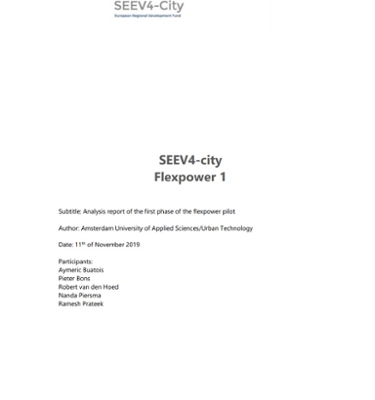SEEV4-city Flexpower 1
analysis report of the first phase of the flexpower pilot
Verslag
The city of Amsterdam set the ambitious target of having local zero emission transport in 2025. To achieve this challenging goal, the network of public charging stations needs to be developed. This expansion will increase the load on the local electrical network. To avoid overload and instability in the electrical distribution network, smart charging needs to be implemented. During a period of 8 months, from January to Augustus 2018, the Flexpower 1 pilot is one of the 6 pilots of the SEEV4-City project, supported by the North Sea Region Interreg programme.
From the 2100 public charging stations present at this time across the city of Amsterdam, 102 were selected for a split-run testing. 50 of the charging stations were used as reference with a constant available charging current of 25 A. The other 52 were deployed with a time dependent current limitation.
During the peak hours, in the morning, from 7:00 to 8:00 and in the evening from 17:00 to 20:00, the current available for the charging stations is limited to prevent overload. Outside these hours, the current is set to 35 A, a higher value than the reference stations.
During this pilot, data was collected for 8208 users involved in 43904 unique charging sessions. The analysis of this data shows a globally positive impact on the users and the expected result on the power grid.
Indeed, outside the limitation hours, the vehicle charged faster and more vehicles reached a full battery using the Flexpower 1 profile than using the reference profile. Even if the electric battery didn’t reach a full charge, more energy could be transferred to it.
Finally, most of the charging volume associated with the battery electric vehicles could be postponed until after the household energy consumption peak without negatively affecting users
Consequently, the Amsterdam city SEEV4-city pilot was a successful experiment with a positive outcome. It proved possible to shift the electrical vehicle charging peak to later in the evening, occurring daily after the peak in household demand, improving the utilisation ratio of the low voltage electrical network and avoiding grid reinforcement investments. At the same time, most of the BEV users showed a reported improvement in the charging comfort of their vehicles.

